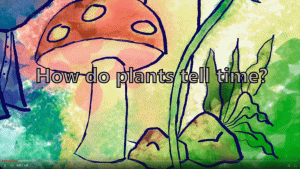How do plants tell time?
Continuing thinking about plant curiosities, another question is: How do plants tell time?
Some flowers open their petals at specific times of the day. Some plants move their leaves up during the day, and move their leaves down during the night. These and other plants' events happen at specific times of the day and follow the internal clock of the plants.
The internal clock of plants is called the circadian clock. This is a molecular mechanism independent of environmental cues. Then, even if the plant is in constant light or darkness, the plant will still move its leaves up during the period of the day, and down during the period of the night, for example.
The main function of the circadian clock in plants is to anticipate the day and night and the cycles of temperature during one day. So everything happens at the right time. When the plants anticipate wrong… well, they may have a decrease in productivity, survival, and fitness.
The main references are:
https://www.ncbi.nlm.nih.gov/pmc/articles/PMC6466001/
https://plantsinmotion.bio.indiana.edu/plantmotion/movements/leafmovements/bean/beansleep.html
Text and video by Maira Marins Dourado, PhD Student EpiSeedLink Marie Skłodowska-Curie Actions
Frontal image by <a href="https://www.freepik.es/vector-gratis/ilustracion-concepto-resorte-adelante_137950301.htm#fromView=search&page=3&position=26&uuid=dbed3ed9-1c24-4a59-85d1-919eeef55494">Imagen de storyset en Freepik</a>
February EpiSeedLink Agenda
EpiSeedLink resumes the training courses in February.
Episeedlink´s fellows will learn about Video development for Public engagement.
Sara Farrona, one of our EpiSeedLink Supervisors, and Niall Flaherty, one expert in the field, both from the University of Galway have been working on preparation for the training.
The training will include the lecture ” The History of Life Project” by John Murray, a guest speaker.
Videos are versatile tools for learning and teaching and are key for public engagement tools.
This course will teach how to create novel Public Engagement material in the form of moving images to trigger fascination about plants and agricultural sciences.
Through theoretical and practical sessions, the Fellows will be trained in storyboard creation and video recording.
Finally, in teams, they will produce 4 public engagement videos that will be shown in our Annual Meeting, and used for public engagement activities.
11th of February, International Day of Women and Girsl in Science
EpiSeedLink wishes you a happy International Day of Women and Girls in Science!
Today, we honor the invaluable contributions of women and girls in the field of science.
From groundbreaking discoveries to innovative research, their dedication and intellect have reshaped our understanding of the world.

Frontal image by <a href="https://www.freepik.es/vector-gratis/dia-internacional-mujeres-ninas-ciencia_133721452.htm#query=international%20day%20women%20and%20grils%20science&position=
4&from_view=search&track=ais&uuid=f30fda9d-c96d-40b1-bdb8-7b3ecc82a0a8">Freepik</a>
Do the plants sleep?
Thinking about plant curiosities? One question is: Do the plants sleep?
In essence, sleep is defined as a behavior. We sleep when we are in a state where a weak disturbance will not awake us, but a strong disturbance will revert this state rapidly.
However, we can explain sleep in animals in other ways. The period of sleep is to save energy, repair the body, and direct the energy to functions less active when we are awake.
During the evening, plants do very different activities compared to the day.
When it is day, plants focus on absorbing light and producing sugar, for example.
When it is night, plants focus on consuming sugar, producing proteins, and
growing.
3- As different as day and night
Then... do plants sleep? Sleep is mainly described as animal behaviour, that appeared very early in animal evolution.
However, different uses of energy happen to plants during the day and night and when animals are asleep and awake.
So, plants don’t sleep like us. But, like humans, do different activities during the evening compared to the day.
The main references are:
https://www.nature.com/articles/s41583-018-0098-9
https://onlinelibrary.wiley.com/doi/10.1111/j.1365-3040.2007.01708.x
Text and video by Maira Marins Dourado, PhD Student EpiSeedLink Marie Skłodowska-Curie Actions
Frontal image by <a href="https://www.freepik.es/foto-gratis/mujer-descansando-hierba_2042318.htm#page=9&query=plantas%20durmiendo&position=31&from_view=search&track=ais&uuid=eb8662d1-a889-4e00-b157-94e6f57cae34">Freepik</a>







